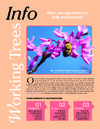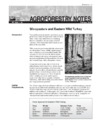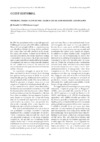Wildlife and Pollinators
Wildlife
Over 50 percent of land use in the United States is dedicated to agriculture. Farms and ranches are therefore a critical piece in the conservation puzzle, as actions taken on these working landscapes have an impact on wildlife and the health of ecosystems. Agroforestry is one option to create benefits for landowners and wildlife.
Most agroforestry practices can be intentionally designed to provide wildlife habitat. The types of wildlife that can benefit will vary with region, ecotype, and landowner preferences and depend on the landscape context and size of the area and the types, spatial configuration, and age of the plantings. Even when practices are primarily designed for economic purposes, substantial wildlife benefits can still occur.
Agroforestry practices can protect aquatic habitat by providing living cover, which intercepts sediment, nutrients, and other materials in runoff and in shallow subsurface water flow, preventing them from getting into streams, lakes, or wetlands. Riparian forest buffers can also reduce bank erosion and in-stream sedimentation, and help maintain water temperatures for cold water fisheries.

(Adobe Stock photo)
Croplands are subject to frequent disturbances that can impact shelter and food sources for wildlife. Agroforestry practices offer more constant habitat in these shifting landscapes, and the woody structure and associated under story increase niche diversity.
Agroforestry systems can help to mitigate the impacts of agricultural pesticides on sensitive wildlife, particularly insects, amphibians, fish, and other aquatic species. Windbreaks, hedgerows, riparian buffers, or alley cropping can help contain drifting pesticides. Tree and shrub layers provide a large surface area over which particles of pesticides may adhere, and also provide wind-speed reduction at the application site, reducing the movement of pesticides off their target.
The conversion of farms and ranches into fragmented and extensively modified urban or suburban patches often has negative impacts on wildlife. Agroforestry can reduce such conversion by diversifying short- and long-term income sources, giving landowners economically-sustainable alternatives. Agroforestry can also decrease the impacts of habitat fragmentation by reducing habitat isolation if plantings are well planned and connected with other habitats.
Pollinators
Over one hundred crop species in North America require a visit from an insect pollinator to be most productive. Whether growing a hedgerow or windbreak, managing a riparian buffer, or farming near forests, agroforestry practices can increase the overall diversity of plants and physical structure in a landscape and, as a result, provide habitat for native pollinators. Agroforestry plantings can also benefit crop pollination.
Many flowering trees and shrubs used in agroforestry can provide critical pollen and nectar for pollinators, particularly early in the season when other flowering plants have yet to bloom. Some trees and shrubs planted for their production value also have pollinator benefits, such as berry-producing shrubs like blueberries and raspberries, ornamental plants like curly willow, and hardwoods like black cherry. Agroforestry plantings can also provide nesting habitat for bees.

(USDA National Agroforestry Center illustration)
Adding agroforestry practices that reduce wind speeds can increase pollination efficiency. Some pollinators, especially honey bees, stop pollinating when it gets too windy. Windbreaks, riparian buffers, hedgerows, and alley cropping are all agroforestry practices that can provide vital pollinator habitat within or adjacent to farm fields requiring insect pollination. Agroforestry practices can reduce pollinator contact with pesticide drift from nearby fields. A systematic review conducted by NAC provides a scientific synthesis on how temperate agroforestry systems can support insect pollinators and their pollination services.
Wildlife and Pollinators Publications
Information Sheets
Infosheet

Infosheet

Infosheet

Infosheet

Brochures
Brochure

Brochure

Inside Agroforestry
Agroforestry Notes
Agroforestry Note

Riparian Forest Buffers: An Agroforestry Practice
DownloadAgroforestry Note

Using Agroforestry Practices To Reduce Pesticide Risks To Pollinators & Other Agriculturally Beneficial Insects
DownloadAgroforestry Note

Enhancing Nest Sites For Native Bee Crop Pollinators
DownloadAgroforestry Note

Windbreak Density: Rules Of Thumb For Design
DownloadAgroforestry Note

Improving Forage For Native Bee Crop Pollinators
DownloadAgroforestry Note

Agroforestry: Sustaining Native Bee Habitat For Crop Pollination
DownloadAgroforestry Note

Silvopasture And Eastern Wild Turkey
Download
Research
Research

Temperate Agroforestry Systems & Insect Pollinators: A Review
DownloadResearch

A Win-win On Agricultural Lands: Creating Wildlife Habitat Through Agroforestry
DownloadResearch

Working Trees: Supporting Agriculture And Healthy Landscapes
DownloadResearch

Enhancing Ecosystem Services: Designing For Multifunctionality
DownloadResearch

Connecting Landscape Fragments Through Riparian Zones
DownloadResearch

A Role For Agroforestry In Forest Restoration In The Lower Mississippi Alluvial Valley
DownloadResearch

Riparian Forest Buffers: Building A Sustainable Bioenergy Future
DownloadResearch

Creatively Communicating Conservation Complexity
DownloadResearch

Colloque Aménagement D'une Zone Riveraine Multifonctionnelle: Pour Une Plus Grande Biodiversité En Milieu Agricole
DownloadResearch

Riparian Buffer Design Guidelines For Water Quality And Wildlife Habitat Functions On Agricultural Landscapes In The Intermountain West
DownloadResearch

Managing Agricultural Landscapes For Environmental Quality: Strengthening The Science Base
DownloadResearch

Developing And Extending Sustainable Agriculture: A New Social Contract
DownloadResearch

Perennial Crops For Bio-fuels And Conservation
DownloadResearch

Tool Time: Melding Watershed And Site Goals On Private Lands
DownloadResearch

Synthesis Of Design Guidelines And Experimental Data For Water Quality Function In Agricultural Landscaps In The Intermountain West
DownloadResearch

Wher Should Buffers Go? Modeling Riparian Habitat Connectivity In Northeast Kansas
DownloadResearch

Computer-based Tools For Decision Support In Agroforestry: Current State And Future Needs
DownloadResearch

Channel Aggradation By Beaver Dams On A Small Agricultural Stream In Eastern Nebraska
DownloadResearch

Integration Of Woody Buffers At Three Levels Of Spatial Scale In The Urban/rural Interface In Lincoln - Lancaster County, Nebraska
DownloadResearch

CBD Technical Series No. 10 - Interlinkages Between Biological Diversity And Climate Change
DownloadResearch

The Fourth P: Planning For Multi-purpose Riparian Buffers
DownloadResearch

Agroforestry And GIS: Achieving Land Productivity And Environmental Protection
DownloadResearch

Ecobelts: Reconnecting Agriculture And Communities - Case Studies
DownloadResearch

Ecobelts: Reconnecting Agriculture And Communities
DownloadResearch

Evaluation Of A Collaborative Model: A Case Study Analysis Of Watershed Planning In The Intermountain West
DownloadResearch

Planning For Multi-purpose Riparian Management
DownloadResearch

Landscape Scale Planning For Conservation Buffers In The Corn Belt
DownloadResearch

An Ecological Foundation For Temperate Agroforestry
DownloadResearch

Perspective: Agroforestry And Sustainability: Making A Patchwork Quilt
Download
More Publications
More Publications

More Publications


















































